Posted by
Related reading
How to Increase Survey Response Rate - Top Strategies for Success
Boost your survey response rate with these effective strategies. Learn practical tips to engage participants and gather valuable insights. Read more!
The Best Survey Apps for Shopify - Enhance Customer Feedback in 2025
Discover the top survey apps for Shopify to boost customer feedback and improve your store's performance. Read the article to find the best fit for you!
Top 10 NPS Survey Tools to Measure Customer Satisfaction Effectively
Discover the best NPS survey tools to effectively measure customer satisfaction and enhance your feedback strategy. Read this article to find the right fit!

Master NPS: How to Calculate Net Promoter Score
Understanding how to calculate NPS (Net Promoter Score) is crucial for measuring customer loyalty. Start by surveying your customers, categorize their responses, and use a simple formula for NPS: how to calculate it effectively. This guide will explain each step to ensure you get reliable results.
Key Takeaways
- Net Promoter Score (NPS) is a crucial metric for assessing customer loyalty and satisfaction by categorizing respondents into Promoters, Passives, and Detractors.
- NPS is calculated by subtracting the percentage of Detractors from the percentage of Promoters, offering a clear indicator of customer sentiment and areas for improving customer satisfaction with your product.
- Automating the NPS measurement process and using industry benchmarks can enhance the accuracy of results and guide strategic decisions to improve customer experience.
Understanding Net Promoter Score (NPS)
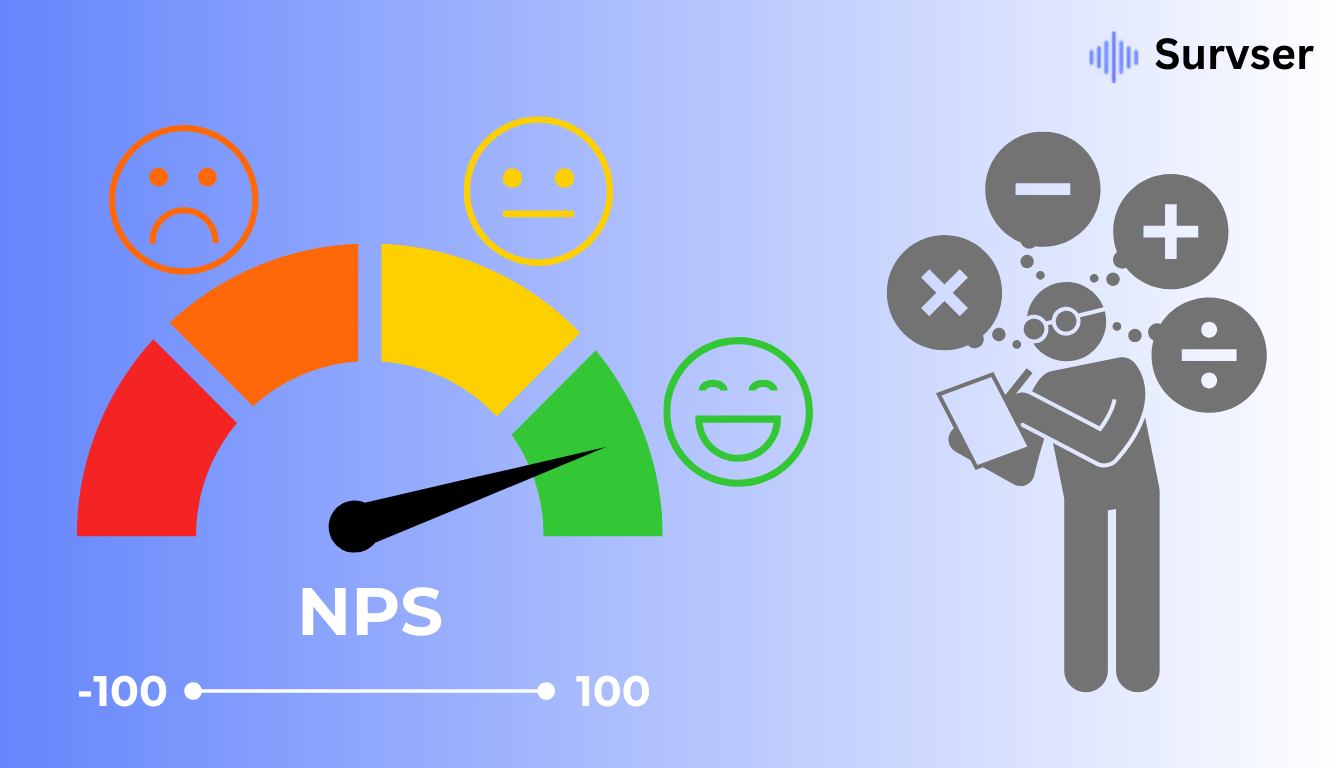
Net Promoter Score (NPS) is a key metric designed to gauge customer satisfaction and loyalty. Unlike other metrics that focus on specific transactions, NPS evaluates general customer sentiment and loyalty over time. This makes it a powerful tool for businesses looking to understand their customers’ overall experience and likelihood to recommend their brand to others.
The NPS methodology is widely adopted across various industries, enabling businesses to compare their performance against industry standards. It categorizes customers into three groups based on their survey responses: Promoters, Passives, and Detractors. Promoters are enthusiastic customers likely to recommend your brand, Passives are satisfied but unenthusiastic, and Detractors are unhappy customers who may discourage others from using your products or services.
Quantifying NPS helps improve business strategies by providing actionable insights into customer satisfaction and loyalty levels. Regularly tracking NPS offers valuable data that businesses can use to make informed decisions and take actions that enhance customer relationships.
The NPS Calculation Formula
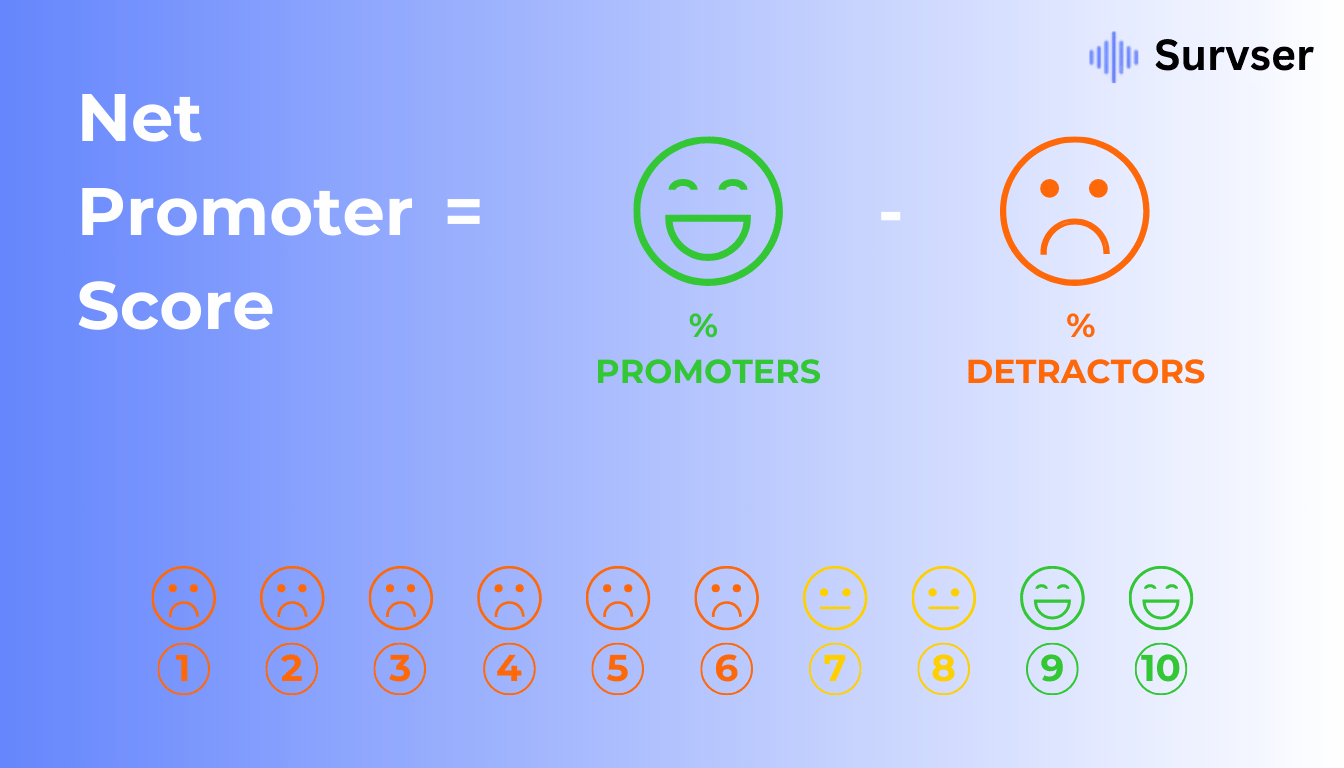
Net Promoter Score (NPS) is calculated using a simple net promoter score formula: Percentage of Promoters minus Percentage of Detractors. This straightforward approach is one reason why the net promoter system is widely adopted. To calculate net promoter score, the calculation requires only the survey responses.
Applying this formula provides businesses with valuable insights into customer loyalty and satisfaction. The resulting NPS score serves as a clear indicator of how well a company meets customer expectations and offers a benchmark for ongoing improvement.
To quickly and accurately calculate your NPS score, use Survser's free online NPS calculator tool.
Step-by-Step Guide to Calculate NPS
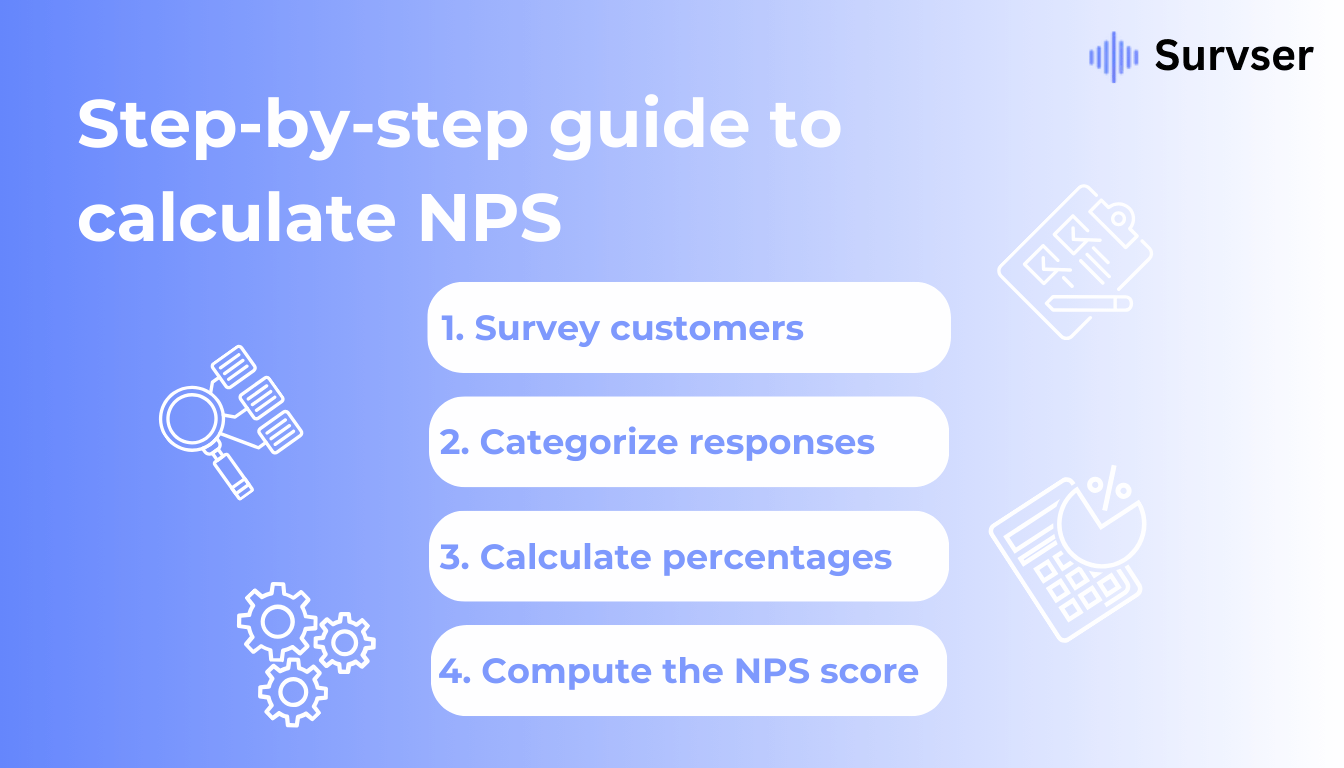
To calculate NPS, follow these steps:
- Survey customers
- Categorize responses
- Calculate percentages
- Compute the NPS score
These steps ensure that the data accurately reflects customer sentiment, offering meaningful insights for your business.
Survey Your Customers
Begin by surveying your customers, asking them to rate their likelihood of recommending your product or service on a scale from 0 to 10. This 11-point scale, standard for NPS responses, captures a broad range of customer sentiments. Survey timing is crucial; sending it too early or too late can skew results.
Using multiple channels like emails, pop-up notifications, and social media to deploy the NPS survey can boost response rates and offer a more comprehensive view of customer sentiment. Following up with promoters through referrals or personalized thank-you messages can further strengthen customer loyalty and enhance customer retention.
Categorize Responses
After collecting survey responses, categorize them into Promoters, Passives, and Detractors. Customers scoring 9 or 10 are Promoters, showing strong loyalty and satisfaction. Scores of 7 or 8 are Passives, while scores from 0 to 6 are Detractors, indicating dissatisfaction.
This categorization greatly influences the overall NPS, helping to distinguish between highly satisfied and dissatisfied customers. Focusing on these categories allows businesses to tailor strategies to different customer segments.
Calculate Percentages
Next, calculate the percentages of Promoters and Detractors. Divide the number of Promoters by the total survey respondents to find the percentage of Promoters, and do the same for Detractors.
For instance, if 70 out of 100 respondents are Promoters, the percentage of Promoters is 70%. Similarly, if 20 out of 100 respondents are Detractors, the percentage of Detractors is 20%.
Compute the NPS Score
Finally, compute the NPS score by subtracting the percentage of Detractors from the percentage of Promoters. For example, with 70% Promoters and 20% Detractors, the NPS score would be 50, reflecting overall customer loyalty and satisfaction.
For instance, if responses from 150 customers are collected, percentages are calculated accordingly, supporting the final NPS calculation. Automated tools can streamline this process and ensure accuracy.
Why Passives Are Not Included in NPS Calculation
Passives, scoring 7 or 8 on the NPS survey, indicate neutrality without a strong opinion about the brand. Their responses don’t influence the overall NPS score as they neither strongly recommend nor discourage others from using the product.
Excluding passives from NPS calculation maintains a clear distinction between promoters and detractors, allowing businesses to focus on the most impactful customer segments. While passives offer valuable feedback, their neutrality doesn’t align with measuring strong loyalty or dissatisfaction.
Tools for Automating NPS Measurement
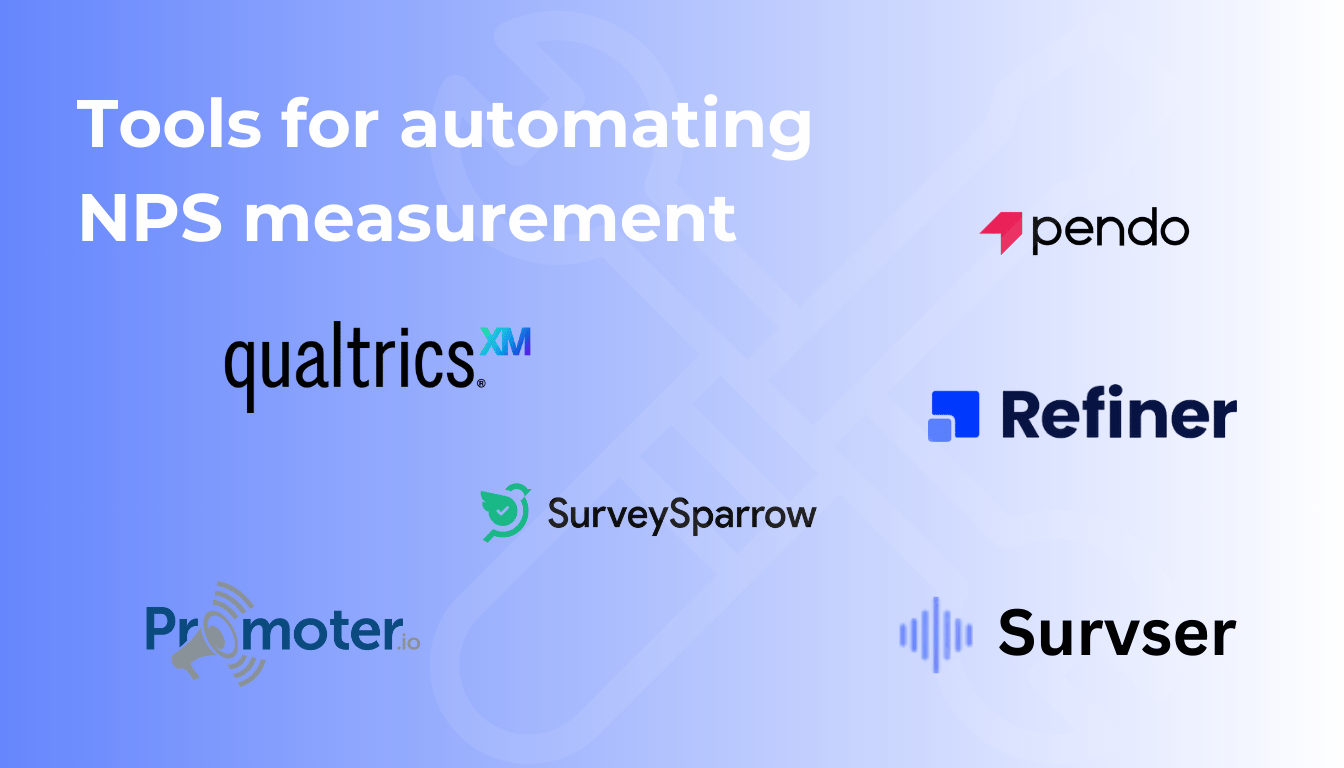
Automating the NPS measurement process saves time and provides more accurate data. NPS software automates data collection and calculation, helping businesses efficiently gauge customer loyalty. Tools like Survser, SurveySparrow offer comprehensive features for managing customer and employee experiences beyond NPS surveys.
Refiner.io enables users to gather various types of customer feedback, including NPS, CSAT, and CES, through multiple delivery channels. Promoter.io integrates with major e-commerce platforms, simplifying NPS feedback collection throughout the customer journey.
Qualtrics offers robust data analysis capabilities, allowing businesses to analyze NPS data alongside other customer interaction metrics for deeper insights. Zonka Feedback supports offline feedback collection, making it versatile for on-the-spot surveys.
Related: Top 10 NPS Survey Tools to Measure Customer Satisfaction Effectively
Interpreting Your NPS Score
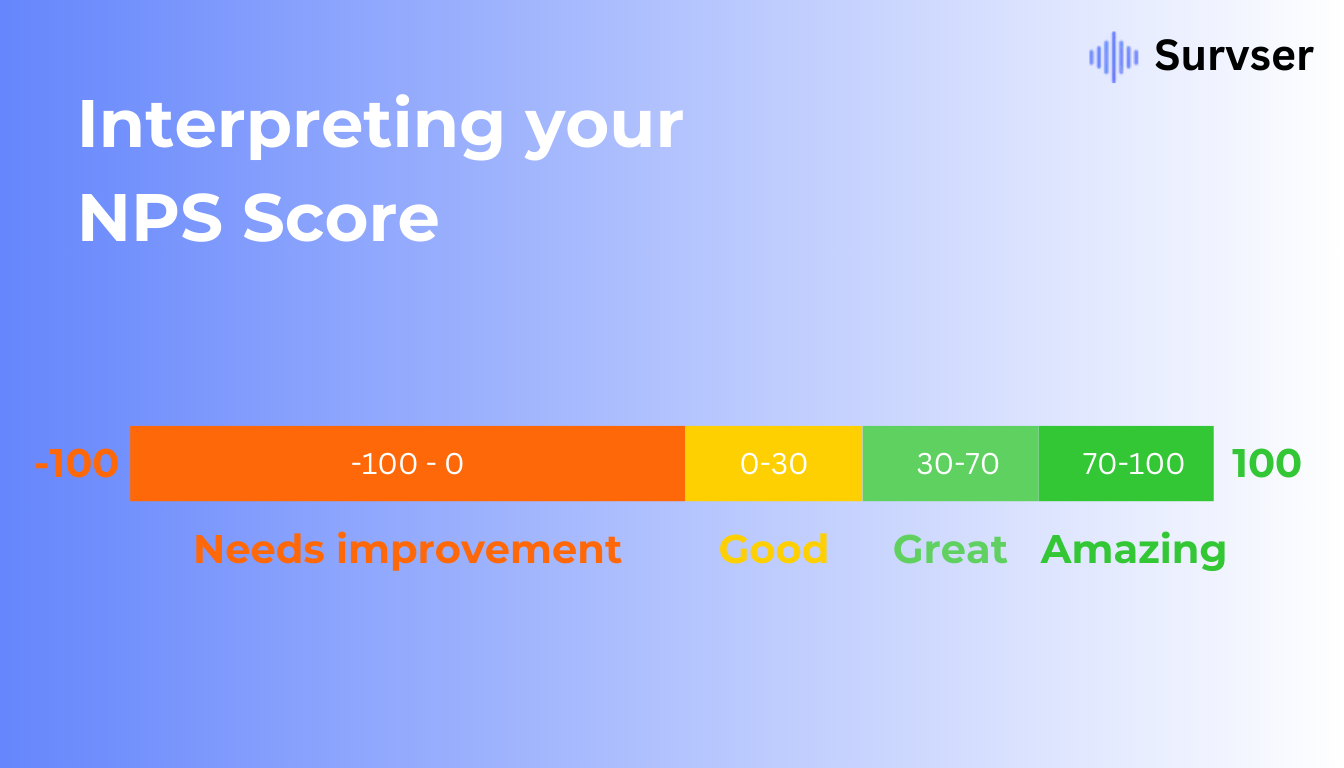
Understanding your NPS score is crucial for interpreting its implications for customer loyalty and satisfaction. NPS scores range from -100 to 100, with higher scores indicating greater customer loyalty and satisfaction.
Analyzing these scores allows businesses to identify areas for improvement and take actions to enhance customer experience, improve their customer satisfaction score, and drive customer success.
Benchmarking Against Industry Standards
Comparing your NPS scores against industry benchmarks helps understand competitive standing. Industry-specific benchmarks provide valuable context for your NPS results, guiding where to focus improvement efforts.
Many industries have third-party-assigned benchmark scores for NPS. Using these benchmarks helps set realistic goals and track progress over time, ultimately enhancing NPS scores based on informed decisions.
Using NPS Data for Business Improvement
NPS data analysis can highlight specific areas needing improvement in the customer experience. For example, Taylor & Hart used NPS data to revamp their manufacturing process, significantly enhancing logistics and delivery. They found that while customers were satisfied with the exceptional customer service, the product needed improvement.
Effectively using NPS data enables businesses to make targeted improvements, enhancing overall customer satisfaction and loyalty. This approach ensures customer feedback translates into meaningful actions that drive business growth.
Designing Effective NPS Surveys
Designing effective NPS surveys is key for gathering accurate, actionable feedback. An effective NPS survey should generally contain no more than ten questions to maintain engagement. The core question asks respondents how likely they are to recommend the product or service on a scale from 0 to 10.
Including a follow-up open-ended question helps gather qualitative insights explaining the given rating. Avoiding redundant questions enhances clarity and focuses on collecting new insights, making the survey more effective.
Common Pitfalls in NPS Calculation
Avoiding common pitfalls in NPS calculation is crucial for obtaining accurate results. One critical aspect is gathering enough data; more data leads to more accurate NPS calculations. Another common mistake is altering the wording of the NPS question, which can skew results.
Ensuring accurate feedback involves using the standard NPS question and collecting responses from a large, representative sample of your customer base. Following these best practices helps avoid common pitfalls and achieve reliable NPS results.
Summary
Mastering the Net Promoter Score (NPS) methodology offers a significant advantage in understanding and improving customer loyalty and satisfaction. By following the step-by-step process to calculate NPS, leveraging automated tools for efficiency, and interpreting the scores against industry benchmarks, businesses can gain comprehensive insights into their customer base.
The journey from surveying customers to making data-driven improvements is invaluable. Not only does it help in identifying promoters and detractors, but it also provides actionable feedback that can enhance overall customer experience. Embracing NPS as part of your business strategy can lead to stronger customer relationships, higher retention rates, and ultimately, greater business success.
Frequently Asked Questions
What is the purpose of NPS?
The purpose of NPS is to measure customer loyalty by assessing their likelihood to recommend a brand, which aids in enhancing customer retention and relationships.
How is NPS calculated?
NPS is calculated by subtracting the percentage of Detractors from the percentage of Promoters. This formula effectively measures customer loyalty and satisfaction.
Why are Passives not included in the NPS calculation?
Passives are not included in the NPS calculation because their neutral scores do not significantly indicate loyalty or dissatisfaction, leaving the focus on promoters and detractors. As a result, they do not impact the final NPS outcome.
What tools can automate NPS measurement?
Automating NPS measurement can be effectively achieved using tools such as Survser, SurveySparrow, Refiner.io, Promoter.io, Qualtrics, and Zonka Feedback, which provide comprehensive survey features. Selecting the right tool will enhance the efficiency of your feedback collection process.
How can businesses use NPS data for improvement?
Businesses can use NPS data to pinpoint specific areas requiring enhancement, thereby increasing customer satisfaction, as evidenced by successful practices from companies like Taylor & Hart. This data-driven approach is essential for continuous improvement.